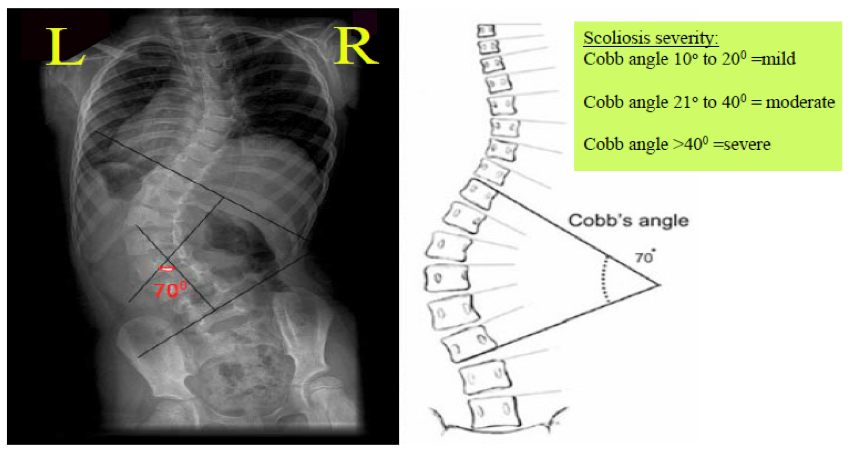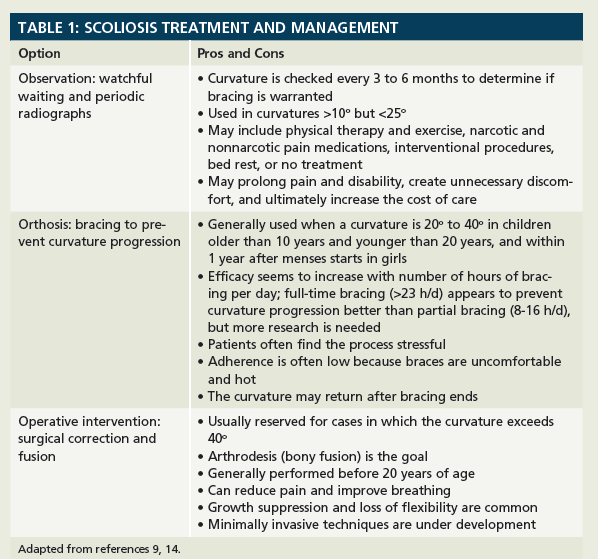Publication
Article
Pharmacy Times
Scoliosis: Disease in 3 Dimensions
Author(s):
A growing number of Americans are feeling the long-term effects of spine curvatures.
A growing number of Americans are feeling the long-term effects of spine curvatures.
Shakespeare described England’s king as a “hunchbacked toad” in his 1592 historical play, Richard III.1 Richard reigned from 1483 until he died in battle in 1485. His men buried him in an unidentified grave. Richard’s adversaries mocked his alleged deformity, and it became a legacy of sorts. Historians wondered if the deformity rumors were true; few paintings of Richard III existed or survived. In 2012, archeologists made history when they excavated a parking lot and exhumed him.2 The exhumation allowed skeletal analysis, confirming that Richard III had scoliosis, but not to the extent that it would have been classified as kyphosis (the medical term for hunchback). 3 Richard III’s enemies tarnished history with lies. What is scoliosis, and what are its repercussions?

We tend to think of the spine as straight, but each spine deviates somewhat. Deviations measured as Cobb angles exceeding 10o—3-dimensional lateral curvatures with axial rotation, usually convex to the right (Online Figure)— are usually noticed in childhood, resulting in a diagnosis of scoliosis. Most scoliosis is idiopathic and is classified by the severity of the curvature and the age at diagnosis (ie, infantile scoliosis affects toddlers younger than 3 years, juvenile scoliosis affects children 4 to 10 years of age, and adolescent scoliosis affects youths 11 to 18 years of age).4 Up to 4% of adolescents have idiopathic scoliosis (IS). Girls develop scoliosis 10 times more often than boys, and the curvature tends to worsen during growth spurts.5
Approximately 6% of adults older than 50 years have scoliosis, which may reflect degenerative scoliosis or progression of childhood IS. Curves in different spine regions progress differently. Curves of 40o to 50o at skeletal maturity generally progress 10o to 15o during a lifetime. Curves larger than 50o at skeletal maturity progress approximately 1o to 2o annually.6 IS has been associated with reduced bone mineral density and an increased likelihood of spinal arthritis, so a consequence may be an increased tendency toward osteoporosis.7 Additionally, standard dual-energy x-ray absorptiometry tests often overestimate bone density in patients with even slight (>5°) axial rotation.8 There is limited information about treatment options for adults with scoliosis.9
Scoliosis can also be congenital or neuromuscular, with the latter related to diseases such as cerebral palsy, muscular dystrophy, spina bifida, and polio.4,5
Symptoms
Historically, researchers have described IS as typically asymptomatic. Today, orthopedic researchers dispute that claim. Most patients receive a diagnosis after they (or their families) perceive a deformity, and about one-fourth of patients present with pain.10,11 Another symptom, psychological stress, is common and serious. Adolescent IS patients are more likely to have suicidal thoughts, strained peer interactions, and concern over body development.12
IS’s progression can be relentless, and at its most severe, it is deadly. Curvatures that approach 70o can compress and compromise the heart and the lungs. Affected patients have uneven hips or shoulders (one shoulder may be higher than the other), or have obvious deformities. Patients may report back pain or fatigue after sitting or standing for a long time. These manifestations may present late in life as IS or degenerative scoliosis progresses.6,9
Patients diagnosed with juvenile IS are at highest risk for complications and symptoms; curvature progresses in nearly 90% of these patients, and approximately 70% eventually need corrective surgery.13 An initial curvature of >25% or a convex curvature to the left is associated with a poorer prognosis.5
Treatment

Collective knowledge about IS’s natural history is still lacking. Once IS is diagnosed, most orthopedic experts select the appropriate treatment from among “the 3 Os”: observation, orthosis, and operative intervention. Selecting the best treatment (Table 19,14) for specific patients is complicated, as skeletal maturity is a critical factor, the risk of progression varies considerably, and long-term consequences are difficult to predict.
Implications in the Pharmacy
Scoliosis may not be a primary reason that patients seek care in the pharmacy, but a growing number of Americans, especially older Americans, are feeling the long-term effects of spine curvatures. Table 25,10,15-18 lists points to remember when caring for patients with scoliosis.

Endnote
Richard III’s exhumation brought muchneeded attention to scoliosis, its prevalence, and its treatments. Scoliosis can cause lifelong problems, including pain. As our population ages, pharmacists will see more patients, elders in particular, who have back pain from spine curvatures. Appropriate counseling can help these patients medicate appropriately.
Ms. Terrie is a clinical pharmacist and medical writer based in Haymarket, Virginia.
References
1. Richard III play by Shakespeare. William Shakespeare Info website. www.william-shakespeare.info/shakespeare-play-king-richard-iii.htm. Accessed June 13, 2014.
2. Buckley R, Morris M, Appleby J, King T, O’Sullivan D, Foxhall L. “The king in the car park”: new light on the death and burial of Richard III in the Grey Friars church, Leicester, in 1485. Antiquity. 2013;87:519-538.
3. Appleby J, Mitchell PD, Robinson C, et al. The scoliosis of Richard III, last Plantagenet king of England: diagnosis and clinical significance. Lancet. 2014;383:1944.
4. James JI. Idiopathic scoliosis: the prognosis, diagnosis, and operative indications related to curve patterns and the age of onset. J Bone Joint Surg. 1954;36B:36-49.
5. Smith JR, Sciubba DM, Samdani AF. Scoliosis: a straightforward approach to diagnosis and management. JAAPA. 2008;21:40-45.
6. Weinstein SL, Zavala DC, Ponseti IV. Idiopathic scoliosis: long-term follow-up and prognosis in untreated patients. J Bone Joint Surg Am. 1981;63:702-712.
7. Lee WT, Cheung CS, Tse YK, et al. Association of osteopenia with curve severity in adolescent idiopathic scoliosis: a study of 919 girls. Osteoporosis Int. 2005;16:1924-1932.
8. Jeon YK, Shin MJ, Shin YB, et al. Effect of increased axial rotation angle on bone mineral density measurements of the lumbar spine. Spine J. Feb 2014.
9. Glassman SD, Berven S, Kostuik J, Dimar JR, Horton WC, Bridwell K. Nonsurgical resource utilization in adult spinal deformity. Spine. 2006;31:941-947.
10. Ramirez N, Johnston CE, Browne RH. The prevalence of back pain in children who have idiopathic scoliosis. J Bone Joint Surg Am. 1997;79:364-368.
11. Sato T, Hirano T, Ito T, et al. Back pain in adolescents with idiopathic scoliosis: epidemiological study for 43,630 pupils in Niigata City, Japan. Eur Spine J. 2011;20:274-279.
12. Payne WK 3rd, Ogilvie JW, Resnick MD, et al. Does scoliosis have a psychological impact and does gender make a difference? Spine. 1997;22:1380-1384.
13. Robinson CM, McMaster MJ. Juvenile idiopathic scoliosis. Curve patterns and prognosis in one hundred and nine patients. J Bone Joint Surg Am. 1996;78:1140-1148.
14. Wiemann JM, Shah SA, Price CT. Nighttime bracing versus observation for early adolescent idiopathic scoliosis. J Pediatr Orthop. May 2014.
15. Richardson LP, Fan MY, McCarty CA, et al. Trends in the prescription of opioids for adolescents with non-cancer pain. Gen Hosp Psychiatry. 2011;33:423-428.
16. Fouladbakhsh JM, Vallerand AH, Jenuwine ES. Self-treatment of pain among adolescents in an urban community. Pain Manag Nurs. 2012;13:80-93.
17. Kozlowska K, Rose D, Khan R, Kram S, Lane L, Collins J. A conceptual model and practice framework for managing chronic pain in children and adolescents. Harv Rev Psychiatry. 2008;16:136-150.
18. Lowry F. Prescription opioid abuse in the elderly an urgent concern. www.medscape.com/viewarticle/776128. Accessed June 10, 2014.







